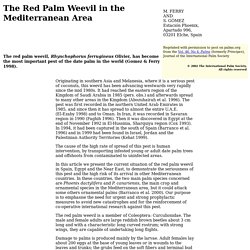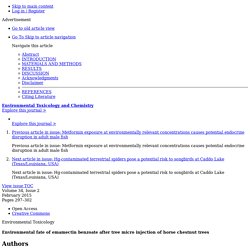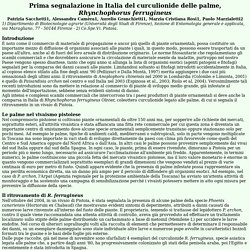

Tesi etd-04152015-124442. Evaluation of the entomopathogenic fungiMetarhizium anisopliae andBeauveria bassiana against the red palm weevilRhynchophorus ferrugineus. The red palm weevil (RPW,Rhynchophorus ferrugineus (Olivier) (Coleoptera: Curculionidae) is one of the most severe pests of various palm species, including date palms.

While examining the susceptibility of RPW to two entomopathogenic fungi,Metarhizium anisopliae andBeauveria bassiana, strains of the former were found to be more virulent than those of the latter, achieving 100% larval mortality within 6–7 days. The most virulent strains ofM. anisopliae were then tested on RPW eggs and adults. Incubation in a substrate treated withM. anisopliae spores increased egg mortality and reduced their hatchability. The total percentage mortality of eggs and hatched larvae was 80–82%, compared with 34% in the controls. RPW adults were challenged with two types of fungal formulation: dry powder and aqueous suspension. Key words. The Red Palm Weevil in the Mediterranean Area.
Originating in southern Asia and Melanesia, where it is a serious pest of coconuts, this weevil has been advancing westwards very rapidly since the mid 1980s.

It had reached the eastern region of the Kingdom of Saudi Arabia in 1985 (pers. obs.) and afterwards spread to many other areas in the Kingdom (Abozuhairah et al. 1996). The pest was first recorded in the northern United Arab Emirates in 1985, and since then it has spread to almost the entire U.A.E. (El-Ezaby 1998) and to Oman. In Iran, it was recorded in Savaran region in 1990 (Faghih 1996). Then it was discovered in Egypt at the end of November 1992 in El-Hussinia, Sharquiya region (Cox 1993). The cause of the high rate of spread of this pest is human intervention, by transporting infested young or adult date palm trees and offshoots from contaminated to uninfected areas. The red palm weevil is a member of Coleoptera: Curculionidae. Damage to palms is produced mainly by the larvae. Strategie sauver palmiers.ferry gomez.princeps.volume1. Untitled. Environmental fate of emamectin benzoate after tree micro injection of horse chestnut trees - Burkhard - 2014 - Environmental Toxicology and Chemistry.
Abstract Emamectin benzoate, an insecticide derived from the avermectin family of natural products, has a unique translocation behavior in trees when applied by tree micro injection (TMI), which can result in protection from insect pests (foliar and borers) for several years.

Active ingredient imported into leaves was measured at the end of season in the fallen leaves of treated horse chestnut (Aesculus hippocastanum) trees. The dissipation of emamectin benzoate in these leaves seems to be biphasic and depends on the decomposition of the leaf. In compost piles, where decomposition of leaves was fastest, a cumulative emamectin benzoate degradation half-life time of 20 d was measured. In leaves immersed in water, where decomposition was much slower, the degradation half-life time was 94 d, and in leaves left on the ground in contact with soil, where decomposition was slowest, the degradation half-life time was 212 d.
Provide feedback or get help Compost. The Red Palm Weevil in the Mediterranean area.
2013 CONTROLLO BIOLOGICO DEL PUNTERUOLO ROSSO DELLE PALME RHYNCHOPHORUS FERRUGINEUS (OLIVIER) 2008 Uso dell’endoterapia nel controllo del Rhynchophorus ferrugineus (Olivier). 2011 Detecting DeteRiORAtiOn in ROYAL PALM (ROYSTONEA R E G I A ) U S i n g U Lt R A S O n i c t O M O g R A P H i c A n D ReSiStAnce MicRODRiLLing tecHniQUeS. EPPO bullettin on Rinchophoros ferrugineus. 2005 Prima segnalazione in Italia del curculionide delle palme, Rhynchophorus ferrugineus.
Prima segnalazione in Italia del curculionide delle palme, Rhynchophorus ferrugineusPatrizia Sacchetti1, Alessandra Camèra1, Aurelio Granchietti1, Marzia Cristiana Rosi1, Paolo Marzialetti2 1) Dipartimento di Biotecnologie agrarie (Università degli Studi di Firenze), Sezione di Entomologia generale e applicata, via Maragliano, 77 - 50144 Firenze - 2) Ce.Spe.Vi.

Pistoia.IntroduzioneÈ noto come il commercio di materiale di propagazione e ancor più quello di piante ornamentali, possa costituire un importante mezzo di diffusione di organismi associati alle piante i quali, in questo modo, possono essere trasportati da un paese all'altro, anche al di fuori del loro areale di distribuzione originario. Rhynchophorus ferrugineus (Olivier)Distribuzione geografica e piante ospitiRhynchophorus ferrugineus, conosciuto anche come curculionide ferruginoso delle palme, è un coleottero appartenente alla famiglia Curculionidae, sottofamiglia Rhyncophorinae.
1998 The Red Palm Weevil in the Mediterranean Area. Victoria Soroker pubblicazioni sino a maggio 2011.